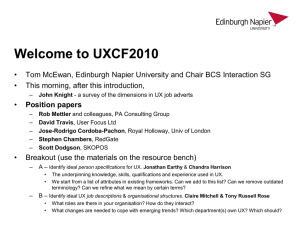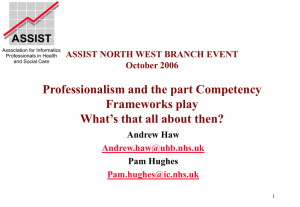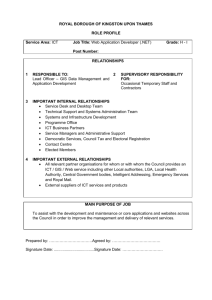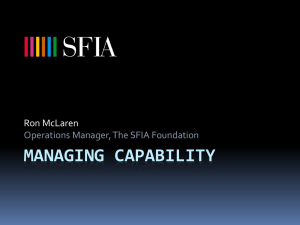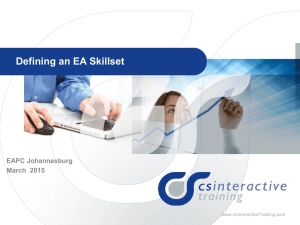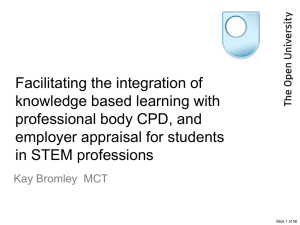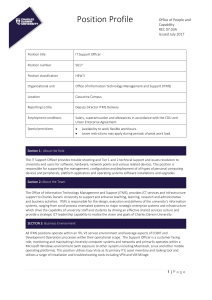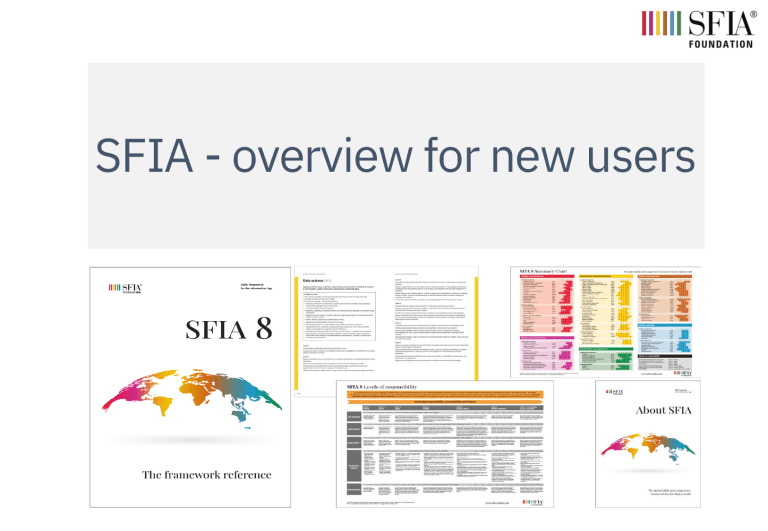
SFIA - overview for new users About SFIA SFIA defines the skills and competencies required by professionals who… design, develop, implement, manage and protect the data and technology that power the digital world. About SFIA — (sfia-online.org) SFIA Evolution SFIA has become the globally accepted common language for the skills and competencies for the digital world. Within the scope of SFIA are many of the world's most in-demand occupations, including professionals working in fields such as… Data science and analytics Business change Information and communications technology Information and cyber security Applied computing and computational science About SFIA — (sfia-online.org) Software engineering Learning and education Human resource and workforce management Digital transformation Digital product development, sales and marketing User centred design Used across industries and organisational types ❑ individuals ❑ small and large teams ❑ departments or business functions ❑ small and medium-sized enterprises ❑ entire organisations with thousands of employees ❑ corporate, public sector and educational environments About SFIA — (sfia-online.org) SFIA and skills management SFIA provides a common language throughout the skills management cycle. By using SFIA, organisations can achieve a consistent and integrated skills and people management system. Plan and organise ❑ Design roles and structure ❑ Conduct workforce planning Acquire ❑ Source/recruit the right skills Deploy ❑ Assign work by capability Assess ❑ Assess skills and performance Analyse ❑ Identify gaps and opportunities Develop ❑ Provide career pathways ❑ Build capability and performance Reward ❑ Compensate and reward SFIA and skills management — (sfia-online.org) The context for SFIA SFIA is industry and business led and at its core is experience. The context for SFIA is the real-world environment in which industry and business operate. Skills proficiency and professional competency are attained at a particular level due to the practice of that skill, at that level, in a real-world situation. The context for SFIA — English (sfia-online.org) Who uses SFIA? The design and structure of SFIA makes it… ❑ a flexible resource Individuals Line managers ❑ with a proven track record ❑ of being adopted and adapted ❑ to support a wide variety of skills- and peoplemanagement related activities. Organisational leaders Human resource professionals Learning and development professionals Operating model and organisation design consultants Recruiters Procurement, supplier management and service providers Professional bodies and their bodies of knowledge Education providers, training providers, curriculum designers Reward and recognition consultants About SFIA — (sfia-online.org) How SFIA works - 7 levels of responsibility ❑ The seven levels provide the backbone of SFIA. ❑ The skills and competencies are described at the levels at which they are practiced within the working world. ❑ Each of the seven levels is also labelled with a guiding phrase to summarise the level of responsibility. ❑ The generic attributes which contain behavioural factors and knowledge statements are described at each of the seven levels. ❑ These combine to provide a common language to describe levels of responsibility across roles in all the professional disciplines represented in SFIA. How SFIA works — (sfia-online.org) Generic SFIA attributes Increasing responsibility, accountability and impact SFIA levels Guiding phrase Level 1 Level 2 Level 3 Level 4 Level 5 Level 6 Level 7 Follow Assist Apply Enable Ensure, advise Initiate, influence Set strategy, inspire, mobilise Generic attributes AUTONOMY Demonstrating increasing levels of autonomy – the level of ownership and accountability for results in the workplace INFLUENCE Demonstrating increasing levels of influence – the level of positive impact with colleagues, clients, suppliers, partners, managers, leaders and the industry as a whole COMPLEXITY Demonstrating the ability to perform work of increasing complexity – the scale and impact of the issues, opportunities, tasks and processes addressed in the workplace BUSINESS SKILLS AND BEHAVIOURS Demonstrating increasing business skills and positive behaviours – operating effectively with the required level of impact in the workplace KNOWLEDGE Demonstrating increased responsibility for developing and applying knowledge to achieve individual and organisational objectives in the workplace How SFIA works — (sfia-online.org) Generic attributes ❑ The levels of responsibility are characterised by generic attributes which describe behavioural factors such as… Generic attributes underpin the levels of responsibility. collaboration, communication, creativity, decision making, execution performance, influence, leadership, learning and professional development, planning, problem solving, security, privacy and ethics. ❑ The generic attributes are: • Autonomy • Influence • Complexity • Business skills • Knowledge The breakdown of each level of responsibility can be found in the levels of responsibility section. SFIA Level 1 is shown here as an example. How SFIA works — (sfia-online.org) Generic attributes Increasing responsibility, accountability and impact Level 7 – Set strategy, inspire, mobilise Level 6 – Initiate, influence Level 4 - Enable Level 3 – Apply Autonomy Level 5 – Ensure, advise Autonomy Autonomy Autonomy Influence At the highest organisational level, has authority over all aspects of a work, including Has defined authority and accountabilitysignificant for actionsarea and of decisions within apolicy formation and app significant area of work, including technical, financial Works under broad direction. Work is often self-initiated. Is fully responsible Inspires the organisation, and influences developments within the industry at Influence for meeting allocated technical and/or group objectiv highestinfluential levels. Makes decisions critical to organisation… Influences policy and strategy formation.the Initiates relationships with internal and external customers, suppliers and par Works under general direction within a clear framework of accountability. Influence Complexity Exercises substantial personal responsibility and autonomy. Influences organisation, customers, suppliers, partners and peers on the Applies the highest level of leadership to the formulation and implementation Complexity contribution of own specialism. Makes decisions which impact of strategy. Performs strategic leadership in Works under general direction. ReceivesInfluence specific direction, accepts guidance Contributes to the development and implementation of policy extensive and strategy. and has work reviewed at agreed milestones. Uses discret Performs highly complex work activities covering technical, Influences customers, suppliers and partners at account level. Makes Autonomy Complexity Business skills decisions which influence the success of projects and team objec Works under routine direction. Uses limited discretion in resolving issues or Implements and executes policies aligned to strategic plans. Performs an Has a full range of strategic management and leadership skills. Influence Business skills enquiries. Determines when to seek guidance in unexpect… extensive range and variety of complex technical and/or prof Communicates Interacts with and influences colleagues.Complexity May oversee others or make Demonstrates leadership in organisational management.the potential impact of emerging practices and technologies Autonomy organisations and and the individuals decisions which impact routine work assigned to individuals or srange of complex technical or professional activities, Understands and communicates industryon developments, role andand assesses the risks of using or not using Works under close direction. Uses little discretion in attending to enquiries. Is Work includes a broad Influence Business skills such practices and technologies. impact of technology. expected to seek guidance in unexpected situations. in a variety of contexts. Investigates, defines and reso Interacts with and may influence immediate colleagues. May have some Establishes governance to address business risk. Demonstrates leadership in operational management. Manages and mitigates organisational risk. Complexity external contact with customers, suppliers and partners. Aware o alignof with and options for continual Balances the requirements of proposals Ensures with the proposals broader needs thethe strategic direction of the organisation. Performs a range of work, sometimes complex and non-routine, in a variety of Analyses requirements and advises on scope Influence Business skills Fosters a learning and growth culture across the organisation. operational improvement. organisation. environments. Applies a methodical approach to routine a Minimal influence. May work alone or interact with immediate colleagues. Communicates fluently, orally and in writing, and can complex Assess the impact of legislation and ac… Assesses andpresent evaluates risk. Complexity Promotes a learning and growth culture in their area of accountability. information to both technical and non-technical wheninto engaging Takes allaudiences requirements account when making proposals. with relevant legislation and the need for services, Performs a range of work activities in varied environments. Leads on compliance Business skillsMay contribute to with colleagues, users/customers, suppliers andown partners. Complexity Shares knowledge and experience and encourages learning and growth. Knowledge routine issue resolution. May apply creative thinking o products and working practices to provide equal access an Demonstrates effective oral and written communication skills when Selects appropriately from, engaging and assessesAdvises the impact of change to applicable Performs routine activities in a structured environment. Requires assistance on available standards, methods, tools, applications and processes Has established a broad and deep business knowledge including the on issues with colleagues, users/customers, suppliers and partners. standards, methods, tools, applications and processes relevant to own and can make appropriate choices from in resolving unexpected problems. Participates in theskills ge relevant to group specialism(s) activities and practices of own organisation and a broad knowledge Business Knowledge Understands and effectively applies appropriate methods, tools, applications specialism. alternatives. Has sufficient oral and written communication skills for effective engagement and processes. Demonstrates an awareness of risk and takes an analytical approach to work. Has developed business knowledge of the activities and practices of own Business skills Understands… with colleagues and internal users/customers. organisation and those of suppliers, partners, competitors an Demonstrates judgement and a systematic approach to work. Maximises the capabilities of applicati Has sufficient oral and written communication skills for effective engagement Understands and uses appropriate methods, tools, applications and Effectively applies digital skills and explores these capabilities for their role. with immediate colleagues. Knowledge processes. Learning and professional development — takes the initiative to develop own Knowledge Uses basic systems and tools, applications and processes. Is fully familiar with recognised industry bodies of knowledge both generic Demonstrates a rational and organised approach to and work. knowledge skills Has a thorough understanding of recognised generic industry bodies of Demonstrates an organised approach to Has work. Has basic digital skills learn and specific, and knowledge of the business, suppliers, p sufficient digital skills forto their role. knowledge and specialist bodies of knowledge as necessary. Has and use applications and tools for their role. Learning and professional development — identifies and negotiates own Knowledge Learning and professional development — contributesopportunities. to identifying own development Has sound generic, domain and specialist knowledge necessary to perform development opportunities. Security, privacy and ethics — is fully aware of organisational standards effectively in the organisation typically gained from recogni Security, privacy and ethics — understands and complies with organisational Level 2 - Assist Autonomy Level 1 – Follow standards. Knowledge Has gained a basic domain knowledge. Demonstrates application of essential generic knowledge typically found in industry bodies of kn… Has a basic generic knowledge appropriate to area of work. Applies newly acquired knowledge to develop new skills. Knowledge Levels of responsibility — (sfia-online.org) A SFIA professional skills definition SFIA full framework view — (sfia-online.org) Each skill description comprises an overall definition of the skill, some guidance notes and a description of the skill at each of up to seven levels at which the skill might be exercised. These descriptions provide a detailed definition of what it means to practice the skill at each level of responsibility. SFIA professional skills SFIA full framework view — (sfia-online.org) SFIA professional skills SFIA full framework view — (sfia-online.org) SFIA professional skills Professional skills and generic attributes work together. ❑ The consistency of the levels of responsibility carries forward into the professional skills. ❑ A description of a skill at a level is written so that it is consistent with the level of responsibility at that level. ❑ This approach ensures the consistency of the levels throughout the whole framework, making it solid and robust. ❑ It also integrates behaviours/behavioural factors and professional skills at a level combining to describe overall responsibility, accountability and impact. How SFIA works — (sfia-online.org) SFIA 8 - resources Core framework Navigation Summary chart, pdfs and Excel 7 levels of responsibility 121 professional skills SFIA 8 5 generic attributes 495 skill level descriptions Categories and subcategories SFIA views Related skills for website browsing Tools and resources ✓ Mappings to industry frameworks ✓ Standard skills profiles ✓ Assessment guidelines ✓ Links to c.50 bodies of knowledge ✓ User stories SFIA 8 - (sfia-online.org) Owned by the global user community ❑ The SFIA Foundation is a not-for-profit organisation ❑ It is built by industry and business for industry and business ❑ Adoption by governments, corporates and individuals in almost 200 countries ❑ Global collaborative development, governance and steering boards ❑ A 20+ year track record of successful use ❑ Proven sustainability with an established ecosystem and trusted infrastructure ❑ A neutral approach – it is not aligned to any specific technologies, vendors or professional bodies About SFIA — English (sfia-online.org) Free of charge for most non-commercial use Important: you need a licence to use SFIA ❑ For personal career development and for the majority of internal use for staff management, SFIA is available free of charge. ❑ There is a modest licence fee for large organisations using SFIA and for organisations that use SFIA for commercial purposes ❑ As a not-for-profit, the SFIA Foundation does not seek commercial gain over and above its subsistence needs. ❑ The licence fee supports the continued development of the framework and ecosystem support ❑ Organisations and individuals who contribute a licence fee can be proud that they are helping the continued development of the industry Licensing SFIA (sfia-online.org) WWW.SFIA-ONLINE.ORG

